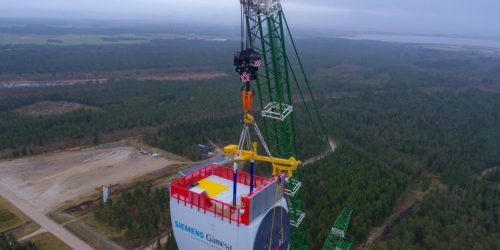Siemens Gamesa Renewable Energy’s new financial strategy will look familiar to those following the pinched U.S. shale sector: the German-Spanish wind turbine manufacturer plans to focus less on breakneck growth, and more on profitability and cash generation.
“We cannot live from volume,” C.E.O. Andreas Nauen said on August 27th in a conference call as the company unveiled its new strategy. “We have to make a profit.”
With revenue of more than €10 billion in 2019, Siemens Gamesa has emerged as the world’s number two builder of the Statue of Liberty-sized wind turbines now proliferating across Europe, the U.S. and Asia, lagging only Denmark’s Vestas Wind in total capacity installed last year. But COVID-19 shutdowns and slowdowns have spoiled Siemens Gamesa’s growth plans, particularly at its lackluster onshore wind segment. The onshore business has been “severely affected” by uncertainties caused by the virus, including delayed contract signings and slowdowns in India and Mexico. The firm reported a brutal loss of nearly €500 million in the quarter from April through June, after netting a €21 million profit during the same period a year ago.Recommended For You
Its largest competitors have weathered the COVID-19 storm more handily. Industry leader Vestas reported a loss of only €5 million over the same quarter from April through June, partly because its manufacturing sites are concentrated in areas like Asia and Europe that avoided the worst of the virus-related lockdowns. Since the start of the year, shares of both Vestas and Siemens Gamesa have each wafted higher by about the same amount — 45% and 44% respectively — amid the updraft of governments’ combined commitments to renewable energy. But Vestas remains the larger company: it has a market capitalization of just shy of $30 billion, well above Siemens Gamesa’s $18 billion in market value.
In the face of that competition, Siemens Gamesa is battening down the hatches. Nauen, the former head of the company’s offshore segment, pledged to bring more operational efficiency to the lagging onshore sector, which still accounts for most of the company’s installations. “There is very significant potential in our onshore business that we will realize through the turnaround process now underway,” Nauen said.
PROMOTED
The company is giving itself plenty of leeway to right the ship. According to its new road map, financial year 2021 will be considered a “transition year” during which it expects revenues will total €10.2-11.2 billion (or $12.1-13.2 billion) and operating margins will be 3-5%. By 2023, the company expects margins to reach to 8-10%. Nauen said he anticipated a return to profitability for the onshore segment by 2022.
Investors found those expectations underwhelming. Shares of the company fell 5% on the heels of the company’s announcement, Reuters reported.
Yet Siemens Gamesa stands head and shoulders above rivals in one big way: its offshore wind turbine business installs far more turbines each year than competitors. Vestas focuses almost entirely on onshore wind. (A joint venture, MHI Vestas Offshore Wind, run by Vestas and Mitsubishi, is considered separate.) That puts it in a strong position to capitalize on a coming wave of spending on offshore wind around the world. Europe and Asia’s offshore wind boom is already well underway, while orders for more offshore wind are rapidly piling up off the U.S. East Coast.
Offshore wind is dealing with growing pains of its own, of course. As the technology sheds the last vestiges of the generous government subsidies that have supported it for decades, its margins in the near-term are likely to be constrained. But costs are still coming down. According to one study in Nature Energy that focused on Northern Europe, the price paid for electricity from offshore wind farms fell by about 11.9% a year over 2015-19.
Like many top U.S. shale oil and gas drillers, Siemens Gamesa is responding to financial pressure by shedding the growth model that propelled it to near the top of the industry. Unlike in the anxiety-ridden shale sector, however, the future appears bright both for Siemens Gamesa and its rivals.





